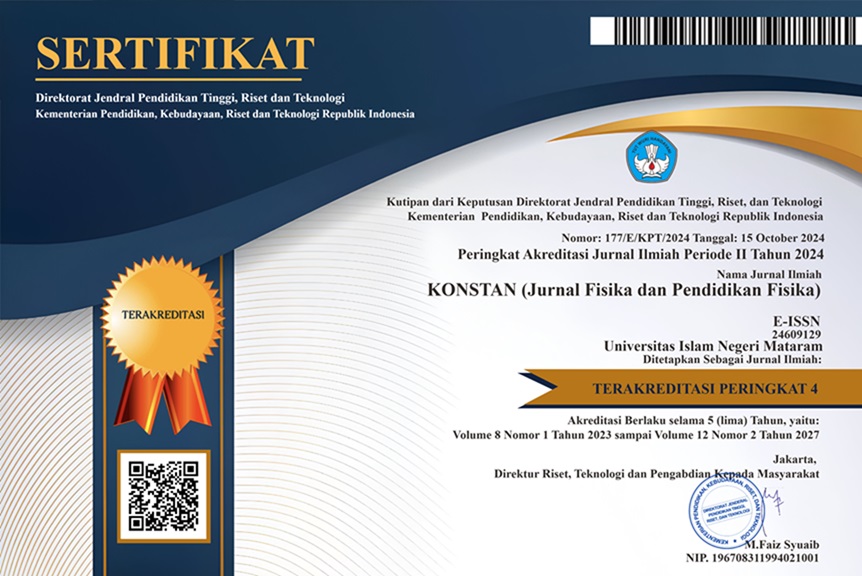Effect of Elevation Angle on Range, Maximum Height, and Travel Time in Parabolic Motion: A PhET Simulation Approach
Abstract
A virtual laboratory is one of the innovative solutions in physics learning, especially to overcome the limitations of space, time, and conventional practical tools. This study aims to analyse the effect of elevation angle on the characteristics of parabolic motion, namely the highest point, farthest range, and maximum travel time. The research method used is a simulation-based quantitative experiment using the PhET Projectile Motion platform. The simulation was conducted with a fixed initial velocity of 10 m/s at three elevation angle variations: 30°, 45°, and 60°, with each angle tested 15 times. Results show that the elevation angle significantly affects all observed variables. The maximum height was reached at an angle of 60°, the furthest horizontal reach was obtained at an angle of 45°, and the longest time to peak occurred at an angle of 60°. However, the relationship between elevation angle and parabolic motion outcomes was not linear. These findings strengthen the theoretical understanding of bullet motion and show that virtual simulation can be a valid and effective alternative medium for the exploration of physics concepts. The integration of virtual laboratories such as PhET into the learning process is recommended to improve the quality of students' understanding of two-dimensional motion phenomena.
Downloads
References
[2] J. Rajagukguk and C. S. Sarumaha, *Pemodelan dan analisis gerak parabola dua dimensi dengan menggunakan aplikasi GUI Matlab*, Medan: Program Studi Fisika, Universitas Negeri Medan, 2018.
[3] P. Artawan, *Fisika Dasar*, Jakarta: Graha Ilmu, 2014.
[4] N. Febriana, "Pengaruh Pembelajaran Berbentuk Simulasi Modellus Terhadap Peningkatan Pemahaman Konsep Gerak Parabola," *Jurnal Pendidikan Madrasah*, vol. 8, no. 2, pp. 227–234.
[5] A. Fauziah and Y. Darvina, "Analisis miskonsepsi peserta didik dalam memahami materi gerak lurus dan gerak parabola pada kelas X SMAN 1 Padang," *Pillar of Physics Education*, vol. 12, no. 1, 2019.
[6] H. D. Young and R. A. Freedman, *Fisika Universitas*, Jilid 1, Jakarta: Erlangga, 2002.
[7] I. Diraya, A. Budiyono, and M. Triastutik, "Kontribusi Virtual Lab Phet Simulation untuk Membantu Praktikum Fisika Dasar," *Phenomenon: Jurnal Pendidikan MIPA*, vol. 11, no. 1, pp. 45–56, 2021.
[8] M. Ulfah, S. Suyidno, and R. Efendi, "Efektivitas laboratorium virtual berbasis simulasi PhET dalam meningkatkan pemahaman konsep fisika siswa," *Jurnal Pendidikan Fisika dan Teknologi*, vol. 6, no. 1, pp. 38–44, 2020.
[9] G. Martínez Borreguero, F. Naranjo-Correa, Á. Pérez, M. Suero, and P. Pardo, "Comparative Study Of The Effectiveness Of Three Learning Environments: Hyper-Realistic Virtual Simulations, Traditional Schematic Simulations And Traditional Laboratory," *Phys. Rev. ST Phys. Educ. Res.*, vol. 7, p. 020111, 2011.
[10] A. A. Rahma, "Efektivitas penggunaan virtual lab phet sebagai media pembelajaran fisika terhadap hasil belajar siswa," *Pedagogy: Jurnal Ilmiah Ilmu Pendidikan*, vol. 8, no. 2, pp. 47–51, 2021.





